Impact of Drip Irrigation Levels on the Growth, Production, and Water Productivity of Quinoa Grown in Arid Climate Conditions
Abstract
1. Introduction
2. Materials and Methods
2.1. Climatic Conditions
2.2. Experiments
2.3. Data Collection
2.4. Data Processing and Analysis
3. Results
3.1. Reference Crop Evapotranspiration ()
3.2. Changes in Water Consumption During the Growth Stages of Quinoa
3.3. Quinoa Actual Crop Coefficient ()
3.4. Biological Yield at Different Growth Stages in Quinoa
3.5. Relationship Between Growth Indicators in Quinoa and Water Consumption During Different Growth Stages
3.6. Factors Affecting the Yield of Quinoa
3.7. Relationship Between Yield, Water Consumption, and Water Productivity
4. Discussion
4.1. The Impact of Different Irrigation Amounts on Water Consumption in Quinoa
4.2. The Impact of Different Irrigation Amounts on the Variation in Actual Crop Coefficients During the Growth Period in Quinoa
4.3. The Impact of Different Irrigation Amounts on the Variation in Growth and Yield in Quinoa
4.4. The Impact of Different Irrigation Amounts on Water Productivity
5. Conclusions
Author Contributions
Funding
Data Availability Statement
Conflicts of Interest
Abbreviations
| WS | wind speed (m·s−1) |
| Tmax | maximum temperature (°C) |
| Tmin | minimum temperature (°C) |
| HR | humidity (%) |
| reference crop evapotranspiration (mm·day−1); | |
| slope of the saturation vapor pressure curve (kPa·°C−1) | |
| radiation (MJ·m−²·day−1) | |
| soil heat flux density (MJ·m−²·day−1) | |
| mean daily air temperature (°C) | |
| wind speed at 2 m height (m·s−1) | |
| saturation vapor pressure (kPa) | |
| actual vapor pressure (kPa) | |
| psychrometric constant (kPa·°C−1) | |
| ETc1–2 | evapotranspiration during the growth stage (mm·day−1) |
| n | total number of soil layers |
| bulk density of the ith soil layer (g·cm−3) | |
| thickness of the ith soil layer (cm) | |
| moisture content at the beginning of the period in the ith soil layer (percentage of dry soil weight) | |
| moisture content at the end of the period in the ith soil layer (percentage of dry soil weight) | |
| irrigation amount during the period (mm) | |
| precipitation amount during the period (mm) | |
| groundwater recharge amount during the period (mm); | |
| drainage amount during the period (sum of surface- and lower-layer drainage; mm) | |
| reference crop evapotranspiration (mm·day−1) | |
| crop water consumption in each growth stage (mm·day−1) | |
| related to factors such as the crop type, variety, crop population, and leaf area index | |
| HI | harvest index |
| Ya | seed yield of quinoa (Mg·day−1) |
| WP | water productivity (kg·m−3) |
References
- Pereira, L.S.; Cordery, I.; Iacovides, I. Improved indicators of water use performance and productivity for sustainable water conservation and saving. Agric. Water Manag. 2012, 108, 39–51. [Google Scholar] [CrossRef]
- Williams, W.D. Salinisation: A major threat to water resources in the arid and semi-arid regions of the world. Lakes Reserv. Res. Manag. 2010, 4, 85–91. [Google Scholar] [CrossRef]
- Paredes, P.; D’Agostino, D.; Assif, M.; Todorovic, M.; Pereira, L.S. Assessing potato transpiration, yield and water productivity under various water regimes and planting dates using the FAO dual Kc approach. Agric. Water Manag. 2018, 195, 11–24. [Google Scholar] [CrossRef]
- Li, J.; Luo, G.; Shaibu, A.S.; Li, B.; Zhang, S.; Sun, J. Optimal fertilization level for yield, biological and quality traits of soybean under drip irrigation system in the arid region of Northwest China. Agronomy 2022, 12, 291. [Google Scholar] [CrossRef]
- Yang, P.; Wu, L.; Cheng, M.; Fan, J.; Li, S.; Wang, H.; Qian, L. Review on drip irrigation: Impact on crop yield, quality, and water productivity in China. Water 2023, 15, 1733. [Google Scholar] [CrossRef]
- Ni, S.; Lyu, J.; Liu, J. Analysis on the evolution trend of drought disaster in China under changing environment. China Flood Drought Manag. 2022, 32, 1–7. [Google Scholar]
- Liu, J. Study on Long-Term Utilization of Agricultural High-Efficiency Water-Saving Irrigation Technology in Xinjiang; Xinjiang Agricultural University: Urumqi, China, 2016. [Google Scholar]
- Ramos, T.B.; Darouich, H.; Pereira, L.S. Mulching effects on soil evaporation, crop evapotranspiration and crop coefficients: A review aimed at improved irrigation management. Irrig. Sci. 2024, 42, 525–539. [Google Scholar] [CrossRef]
- Liu, M.; Wang, G.; Liang, F.; Li, Q.; Tian, Y.; Jia, H. Optimal irrigation levels can improve Maize growth, yield, and water use efficiency under drip irrigation in Northwest China. Water 2022, 14, 3822. [Google Scholar] [CrossRef]
- Wang, J. The distribution and evolution of Xinjiang’s Arid Zone under climate warming and humidification. Arid. Environ. Monit. 2023, 37, 15–21. [Google Scholar]
- Terán-Chaves, C.A.; Montejo-Nuñez, L.; Cordero-Cordero, C.; Polo-Murcia, S.M. Water productivity indices of onion (Allium cepa) under drip irrigation and mulching in a Semi-Srid Tropical Region of Colombia. Horticulturae 2023, 9, 632. [Google Scholar] [CrossRef]
- Wu, F.; Wang, L.; Lin, T.; Wang, J.; Guo, R.; Yue, L.; Tang, Q. Effect of plastic film on evapotranspiration and evaporation of cottons under drip irrigation in Southern Xinjiang. Acta Agric. Boreali-Occident. Sin. 2016, 25, 1636–1642. [Google Scholar]
- Wen, R.; Liu, J.; Zhang, Z. Effects of drought stress on germination and physiological characteristics of different quinoa seeds. Crops 2019, 1, 121–126. [Google Scholar]
- Qureshi, A.S.; Daba, A.W. Differential analysis of five quinoa (Chenopodium quinoa W.) genotypes under different salt stresses in a controlled environment. Am.-Eurasian J. Sustain. Agric. 2020, 14, 14–21. [Google Scholar]
- Hirich, A.; Omari, H.E.; Youssfi, L.E.; Jacobsen, S.E.; Choukr-Allah, R. The combined effect of organic matter amendment and deficit irrigation with treated wastewater on quinoa and pea. In Proceedings of the International Conference on Sustainable Water Use for Securing Food Production in the Mediterranean Region under Changing Climate, Agadir, Morocco, 10–15 March 2013. [Google Scholar]
- Jacobsen, S.E. The Worldwide Potential for Quinoa (Chenopodium quinoa Willd). Food Rev. Int. 2003, 19, 167–177. [Google Scholar] [CrossRef]
- Singh, R.K.; Tutundjin, S.; Rodriguez, J.P. Quinoa: An underutilized crop for nutritional food security from the marginal lands. In Proceedings of the International Workshop on “Plant Stress Biology and Food Security”, ICGEB, New Delhi, India, 18–20 April 2019. [Google Scholar] [CrossRef]
- Hirich, A.; Rafik, S.; Rahmani, M.; Amira, F.; Choukr-Allah, R. Development of quinoa value chain to improve food and nutritional security in rural communities in Rehamna, Morocco: Lessons learned and perspectives. Plants 2021, 10, 301. [Google Scholar] [CrossRef]
- Al-Naggar, A.M.M.; Abd El-Salam, R.M.; Badran, A.E.E.; Boulos, S.T.; El-Moghazi, M.M. Leaf amino acids and anatomical traits of drought tolerant vs sensitive genotypes of quinoa (Chenopodium quinoa Willd.) under elevated Levels of water stress. Annu. Res. Rev. Biol. 2018, 22, 46. [Google Scholar] [CrossRef]
- Geerts, S.; Raes, D.; Garcia, M.; Vacher, J.; Mamani, R.; Mendoza, J.; Huanca, R.; Morales, B.; Miranda, R.; Cusicanqui, J.; et al. Introducing deficit irrigation to stabilize yields of quinoa (Chenopodium quinoa Willd.). Eur. Agron. 2008, 28, 427–436. [Google Scholar] [CrossRef]
- Alizadeh-Zoaj, F.; Sepaskhah, A.R.; Talebnejad, R. Nitrogen application rates influence on yield and water productivity of quinoa under saline irrigation water regimes and saline water table. Plant Nutr. 2023, 46, 3273–3291. [Google Scholar] [CrossRef]
- Aziz, A.; Akram, N.A.; Ashraf, M. Influence of natural and synthetic vitamin C (ascorbic acid) on primary and secondary metabolites and associated metabolism in quinoa (Chenopodium quinoa Willd.) plants under water deficit regimes. Plant Physiol. Biochem. 2018, 123, 192–203. [Google Scholar] [CrossRef]
- Murphy, K.S.; Matanguihan, J. Quinoa: Improvement and Sustainable Production; John Wiley & Sons: Hoboken, NJ, USA, 2015. [Google Scholar]
- Qi, T.M.; Li, Z.J.; Qin, P.Y.; Ren, G.X.; Zhou, B.W. Research and application prospect of quinoa cultivation technology. Agric. Sci. Technol. 2022, 24, 157–165. [Google Scholar]
- Gongbu, T.; Wang, M.; Zhang, C. Preliminary study of biological characters of quinoa in Tibet. Acta Agric. Boreali-Occident. Sin. 1994, 4, 81–86. [Google Scholar]
- Gongbu, T.; Wang, M. Quinoa nutritional character in Tibet. Acta Agric. Boreali-Occident. Sin. 1995, 3, 85–88. [Google Scholar] [CrossRef]
- Liu, S.; Fan, W. Suggestion to promote scale cultivation and formation of production chain of quinoa in Shanxi. Shanxi Agric. Sci. 2011, 39, 767–769. [Google Scholar]
- Wang, N.; Wang, F.; Shock, C.C.; Gao, L.; Meng, C.; Huang, Z.; Zhao, J. Evaluating quinoa lodging risk and yield under different irrigation thresholds, nitrogen rates and planting densities in north-western china. Front. Agric. Sci. Eng. 2022, 9, 614–626. [Google Scholar]
- Huang, J. The inaugural Western China quinoa industry summit and the 2015 annual meeting of the chinese crop science society quinoa branch. Agric. Sci. Technol. 2015, 17, 141. [Google Scholar]
- Tian, J.; Tang, Y.; Dong, Y. Effect of water stress on physiology of quinoa in different developmental stages. J. Biol. 2020, 37, 73–76. [Google Scholar]
- Garcia, M.; Raes, D.; Jacobsen, S.E. Evapotranspiration analysis and irrigation requirements of quinoa (Chenopodium quinoa) in the Bolivian highlands. Agric. Water Manag. 2003, 60, 119–134. [Google Scholar] [CrossRef]
- Algosaibi, A.M.; Badran, A.E.; Almadini, A.M.; El-Garawany, M.M. Research on the Effect of Irrigation Intervals on the Growth and Yield of Quinoa Crop and Its Components. Cut.-Edge Res. Agric. Sci. 2021, 7, 144–154. [Google Scholar] [CrossRef]
- Awa, M.; Zhao, J.; Tumaerbai, H. Deficit irrigation-based improvement in growth and yield of quinoa in the northwestern arid region in China. Sustainability 2024, 16, 4136. [Google Scholar] [CrossRef]
- Wang, T.; Xu, M. Analysis of water resource supply and demand balance in the Mulei Kazakh Autonomous County. Groundwater 2016, 38, 168–170. [Google Scholar]
- Yerkekjiang, H.; Apalar, R.; Liu, H. Analysis of meteorological drought characteristics in spring and summer over the past 51 years in Mulei County, Xinjiang. Hubei Agric. Sci. 2021, 60, 57–63. [Google Scholar] [CrossRef]
- Allen, R.; Pereira, L.; Raes, D.; Smith, M.; Allen, R.G.; Pereira, L.S.; Martin, S. Crop Evapotranspiration: Guidelines for Computing Crop Water Requirements; FAO Irrigation and Drainage Paper 56; FAO: Quebec City, QC, Canada, 1998; p. 56. [Google Scholar]
- Allen, R.G.; Pereira, L.S.; Howell, T.A.; Jensen, M.E. Evapotranspiration information reporting: I. Factors governing measurement accuracy. Agric. Water Manag. 2011, 98, 899–920. [Google Scholar] [CrossRef]
- Yu, Z. Study on Water-Saving Effect of Irrigation Methods and Farmers’ Technology Choice in Northwest China. Ph.D. Thesis, Chinese Academy of Agricultural Sciences, Beijing, China, 2018. [Google Scholar]
- Jia, Y.; Huang, W.; Yang, B. A meta-analysis of yield and irrigation water productivity of cotton under dificit irrigation in China. Cotton Sci. 2023, 35, 195–210. [Google Scholar]
- Bai, Y.; Jia, S.; Luo, T. Effect of irrigation on root distribution characteristics of maize under film drip irrigation. Water-Sav. Irrig. 2016, 11, 19–22+27. [Google Scholar]
- Duan, W. Dynamic Response of Root-Shoot Growth of Summer Maize to Soil Moisture Under Deficit Irrigation; Northwest A&F University: Xianyang, China, 2022. [Google Scholar] [CrossRef]
- Liang, Y. Effects of Different Plant Densities and Nitrogen Fertilizer Rate on Stem Morphology Characteristic and Lodging Resistance in Winter Wheat Under Drip Irrigation; Xinjiang Agricultural University: Urumqi, China, 2018. [Google Scholar]
- Kaya, Ç.I.; Yazar, A.; Sezen, S.M. SALTMED model performance on simulation of soil moisture and crop yield for quinoa irrigated using different irrigation systems, irrigation strategies and water qualities in Turkey. In Proceedings of the International Symposium on Efficient Irrigation Management and Its Effects in Urban and Rural Landscapes, Patras, Greece, 26–28 November 2014; pp. 108–118. [Google Scholar]
- Ince Kaya, C.A. Saltmed model performance for quinoa irrigated with fresh and saline water in a Mediterranean environment. Irrig. Drain. 2016, 65, 37–39. [Google Scholar] [CrossRef]
- Yazar, A.; Sezen, S.M.; Olak, Y.B. Yield response of quinoa to irrigation with drainage water and planting times in the Mediterranean Region. In Proceedings of the Irrimed 2015: Modern technologies, strategies and tools for sustainable irrigation management and governance in Mediterranean agriculture, Bari, Italy, 23–25 September 2015. [Google Scholar]
- Yazar, A.; Incekaya, I.; Sezen, M.S.; Jacobsen, S.E. Saline water irrigation of quinoa (Chenopodium quinoa) under Mediterranean conditions. Crop Pasture Sci. 2015, 66, 37–39. [Google Scholar] [CrossRef]
- Yazar, A.; Sezen IN, S.M.; Tekin, S. Quinoa Experimentation and Production in Turkey; FAO: Adana, Turkey, 2015. [Google Scholar]
- Pulvento, C.; Riccardi, M.; Lavini, A.; d’Andria, R.; Iafelice, G.; Marconi, E. Field trial evaluation of two chenopodium quinoa genotypes grown under rain-fed conditions in a typical mediterranean environment in South Italy. Agron. Crop Sci. 2010, 196, 407–411. [Google Scholar] [CrossRef]
- Adusumilli, R.; Laxmi, S.B. Potential of the system of rice intensification for systemic improvement in rice production and water use: The case of Andhra Pradesh, India. Paddy Water Environ. 2011, 9, 89–97. [Google Scholar] [CrossRef]
- Wang, R. Research on the Optimization of Irrigation Systems for Spring Maize in Shaanxi Province Based on Key Water Security; Xi’an University of Technology: Xi’an, China, 2024. [Google Scholar] [CrossRef]
- Zhu, Y.; Bai, X.; Wang, Y. Experimental study on the crop coefficient (Kc) of cotton in the Xiaoyezi irrigation district. Xinjiang Agric. Reclam. Sci. Technol. 2019, 42, 25–28. [Google Scholar]
- Algosaibi, A.M.; Badran, A.E.; Almadini, A.M.; El-Garawany, M.M. The effect of irrigation intervals on the growth and yield of quinoa crop and Its Components. J. Agric. Sci. 2017, 9, 182–191. [Google Scholar] [CrossRef]
- Kaoutar, F.; Abdelaziz, H.; Ouafae, B.; Redouane, C.A.; Ragab, R. Yield and dry matter simulation using the saltmed model for five quinoa (Chenopodium quinoa) accessions under deficit irrigation in South Morocco. Irrig. Drain. 2017, 66, 340–350. [Google Scholar] [CrossRef]
- González, J.A.; Gallardo, M.; Hilal, M.B.; Rosa, M.D.; Prado, F.E. Physiological responses of quinoa (Chenopodium quinoa Willd.) to drought and waterlogging stresses: Dry matter partitioning. Bot. Stud. 2009, 50, 35–42. [Google Scholar]
- Jensen, C.R.; Jacobsen, S.E.; Andersen, M.N.; Nunez, N.; Andersen, S.D.; Rasmussen, L.; Mogensen, V.O. Leaf gas exchange and water relation characteristics of field quinoa (Chenopodium quinoa Willd.) during soil drying. Eur. Agron. 2000, 13, 11–25. [Google Scholar]
- Fghire, R.; Wahbi, S.; Anaya, F.; Issa Ali, O.; Benlhabib, O.; Ragab, R. Response of quinoa to different water management strategies: Field experiments and saltmed model application results. Irrig. Drain. 2015, 64, 232–238. [Google Scholar]
- Talebnejad, R.; Sepaskhah, A.R. Effect of deficit irrigation and different saline groundwater depths on yield and water productivity of quinoa. Agric. Water Manag. 2015, 159, 225–238. [Google Scholar]
- Ma, L.; Zhang, Y.; Li, Z.; Han, M.; Jiang, F. Effects and comprehensive evaluation of regulated deficit irrigation on mixed seeding of Chenopodium quinoa Willd. and Vicia villosa in alpine desert area. J. Qinghait Univ. 2022, 40, 18–24. [Google Scholar] [CrossRef]
- Geerts, S.; Raes, D. Deficit irrigation as an on-farm strategy to maximize crop water productivity in dry areas. Agric. Water Manag. 2009, 96, 1275–1284. [Google Scholar] [CrossRef]
- Geerts, S.; Raes, D.; Garcia, M.; Condori, O.; Mamani, J.; Miranda, R.; Cusicanqui, J.; Taboada, C.; Yucra, E.; Vacher, J. Could deficit irrigation be a sustainable practice for quinoa (Chenopodium quinoa Willd.) in the Southern Bolivian Altiplano? Agric. Water Manag. 2008, 95, 909–917. [Google Scholar]
- Geerts, S.; Raes, D.; Garcia, M.; Miranda, R.; Cusicanqui, J.A.; Taboada, C.; Mendoza, J.; Huanca, R.; Mamani, A.; Condori, O. Simulating yield response of quinoa to water availability with AquaCrop. Agron. J. 2009, 101, 37–39. [Google Scholar]
- Geerts, S.; Raes, D.; Garcia, M.; Taboada, C.; Miranda, R.; Cusicanqui, J.; Mohizha, T.; Vacher, J. Modeling the potential for closing quinoa yield gaps under varying water availability in the Bolivian Altiplano. Agric. Water Manag. 2009, 96, 77–89. [Google Scholar]
- Zhao, H.; Cai, D.; Wang, H.; Yang, Y.; Wang, Y.; Zhang, K.; Qi, Y.; Zhao, F.; Chen, F.; Yue, P. Progress and prospect on impact of drought disaster on food security and its countermeasures. Arid. Meteorol. 2023, 41, 187–206. [Google Scholar]
- Yang, L. 2019 water resource situation and Its development and utilization in bortala mongol autonomous prefecture. Energy Conserv. 2021, 10, 113–114. [Google Scholar] [CrossRef]
- Zhang, Z.; Huang, C.; Fan, Y. The effect of drip irrigation volume on the growth, development, yield, and water use efficiency of spring wheat in Northern Xinjiang. J. Irrig. Drain. 2024, 43, 22–27. [Google Scholar] [CrossRef]
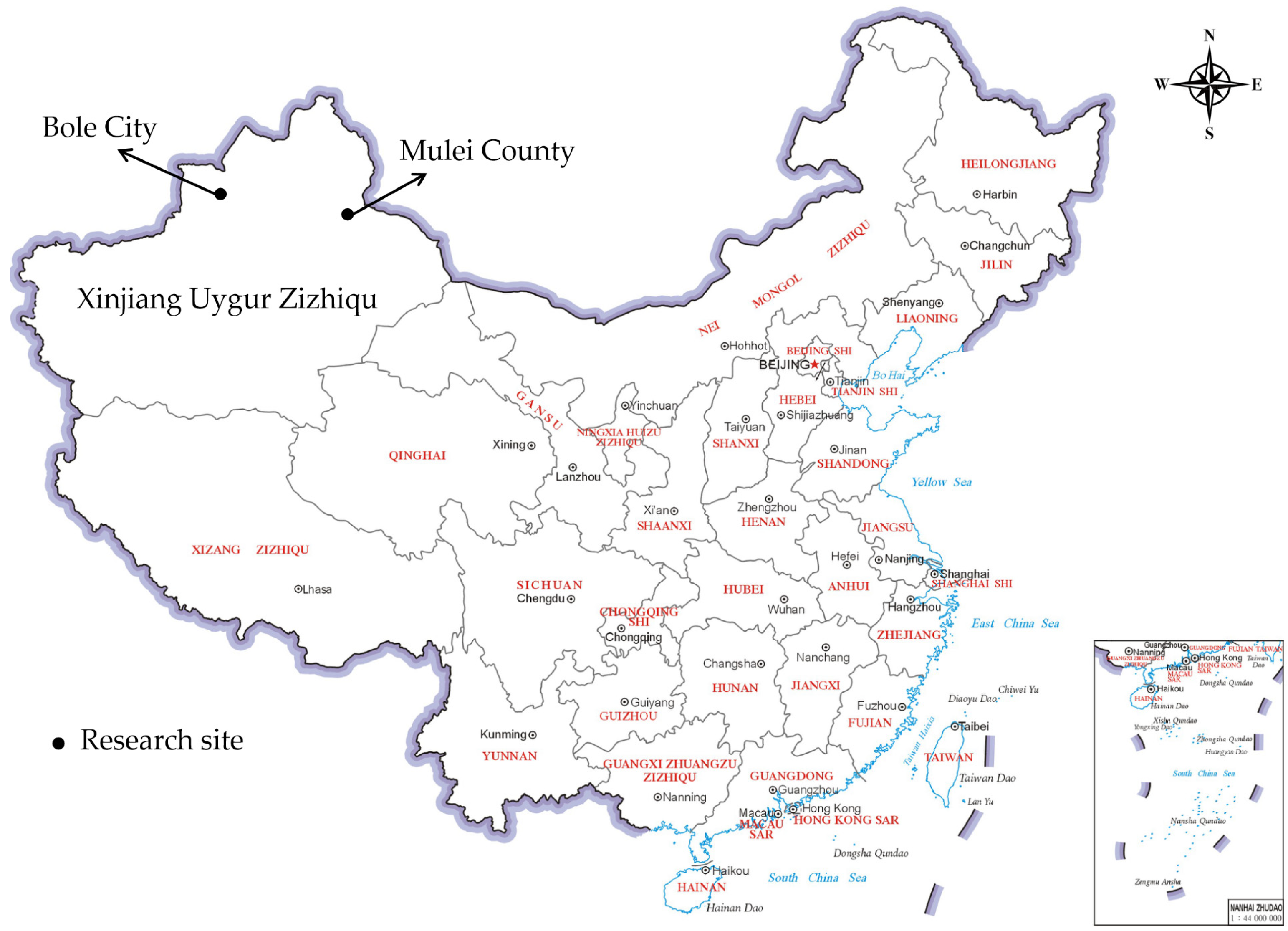
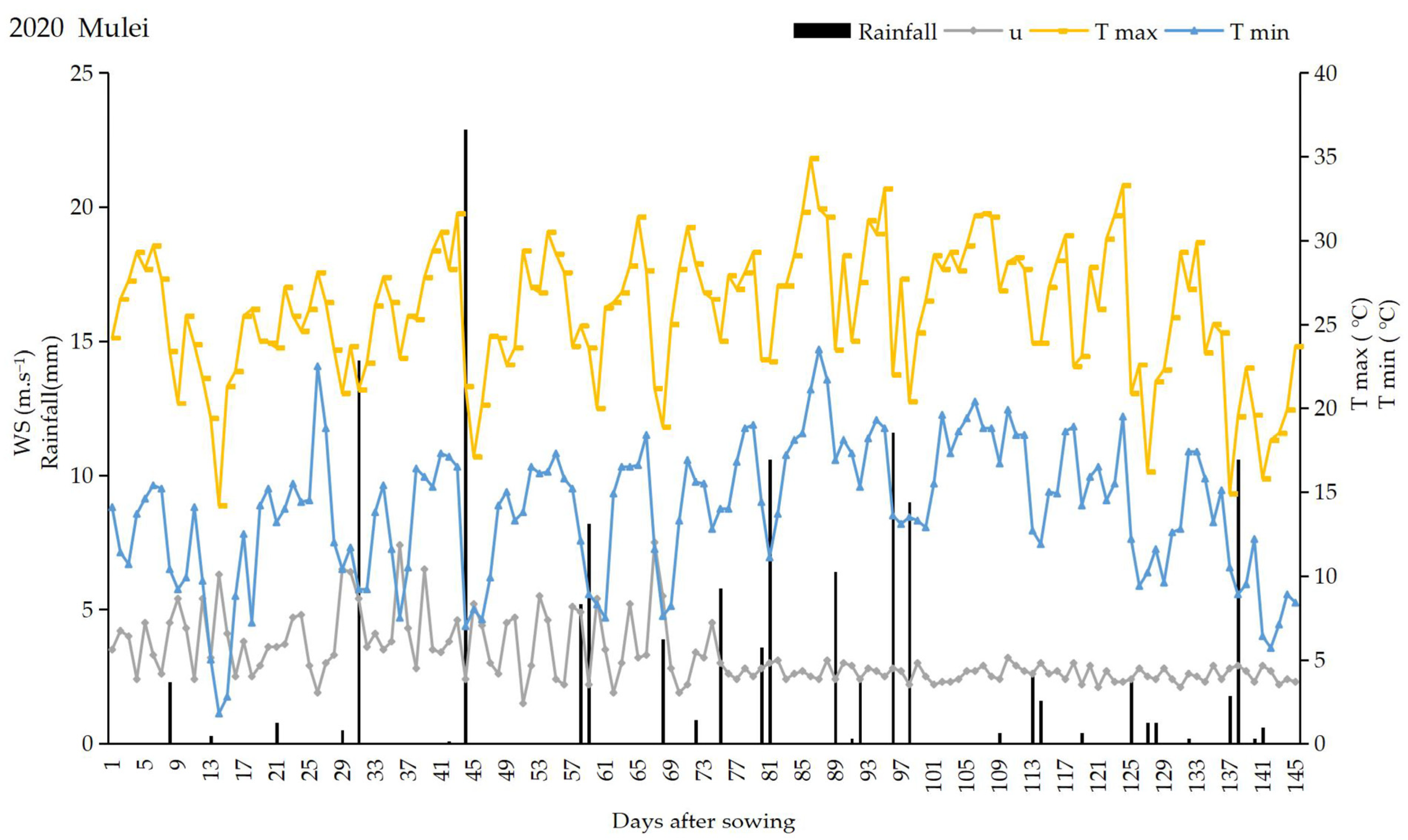


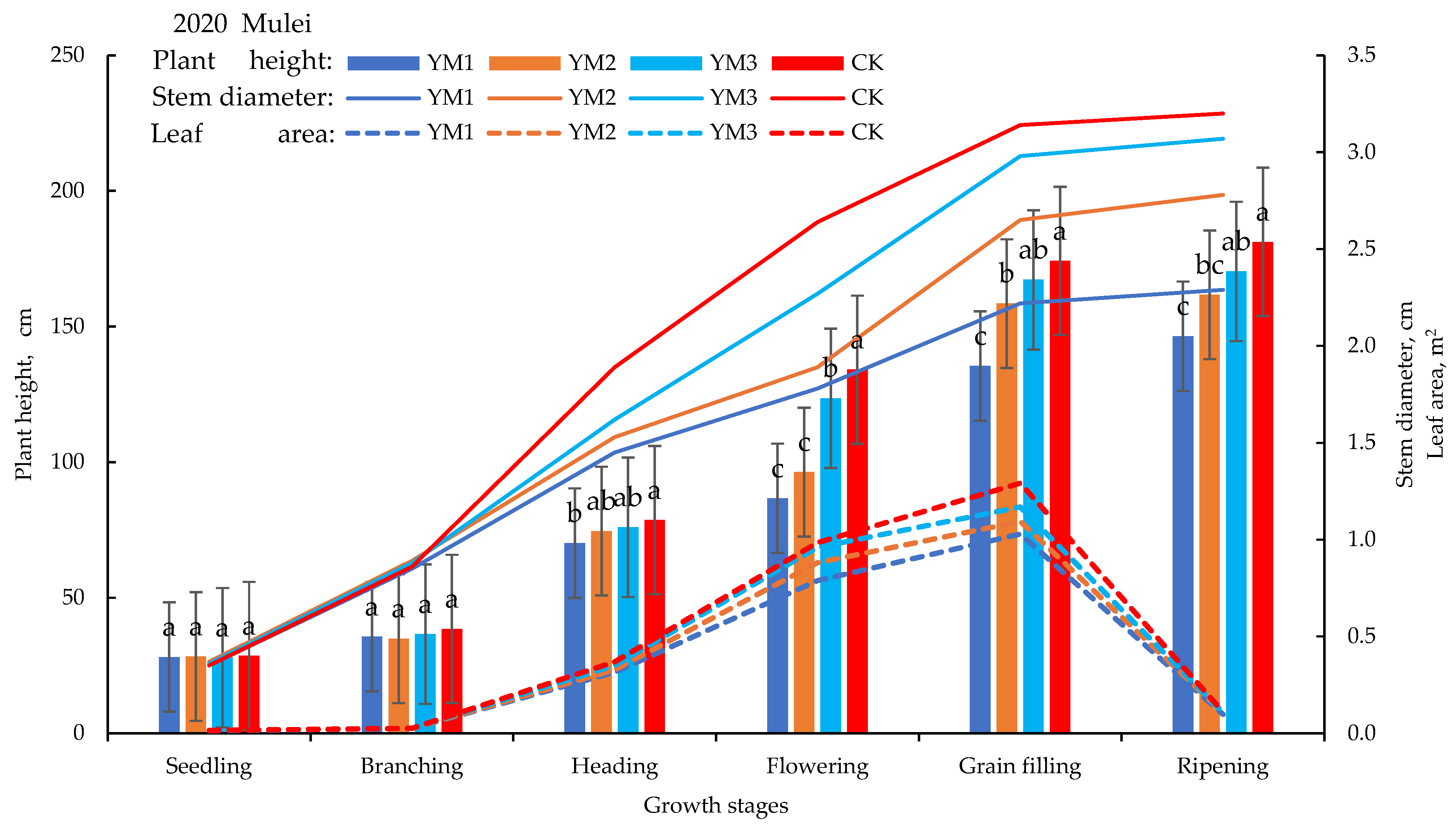
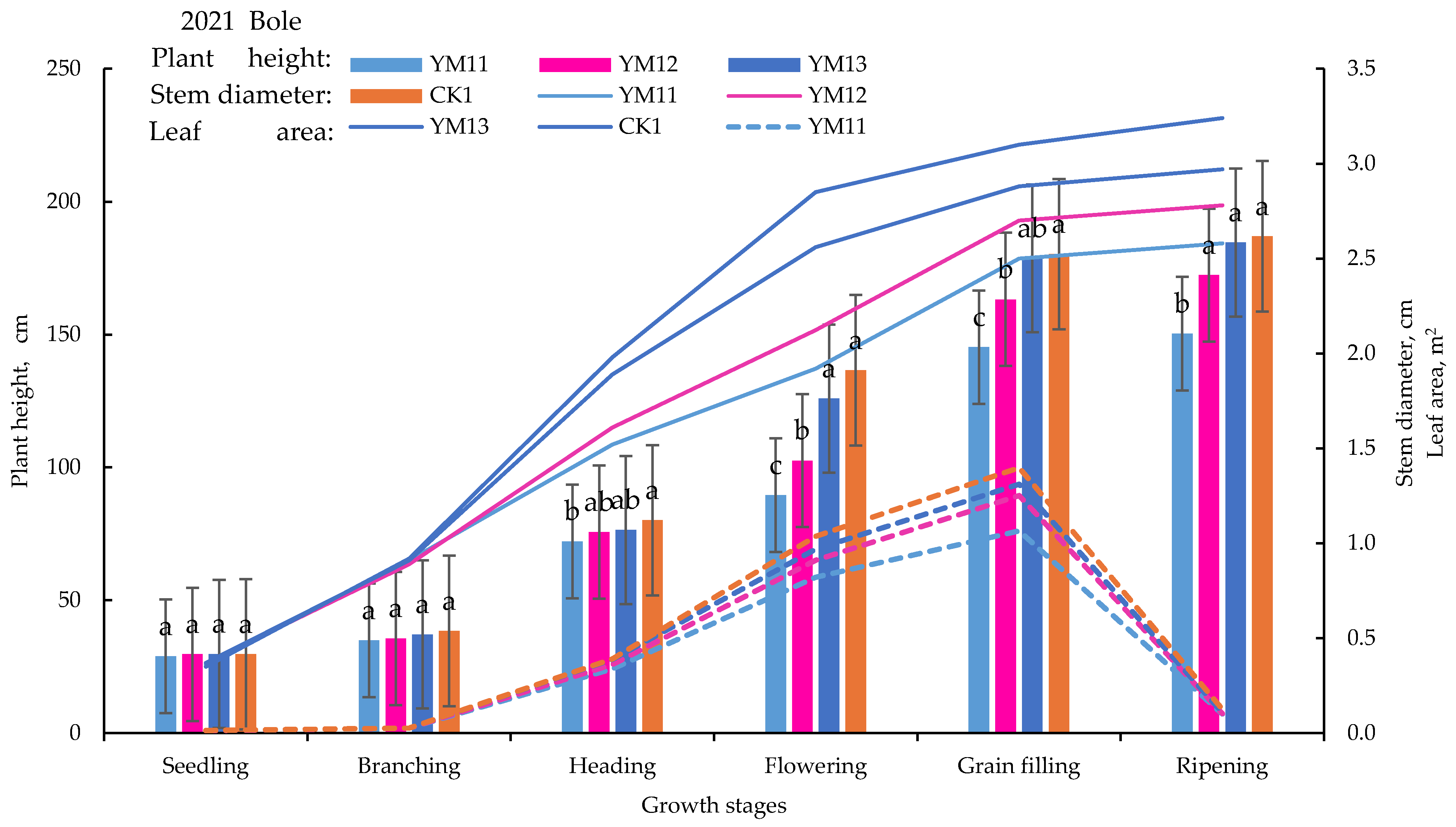
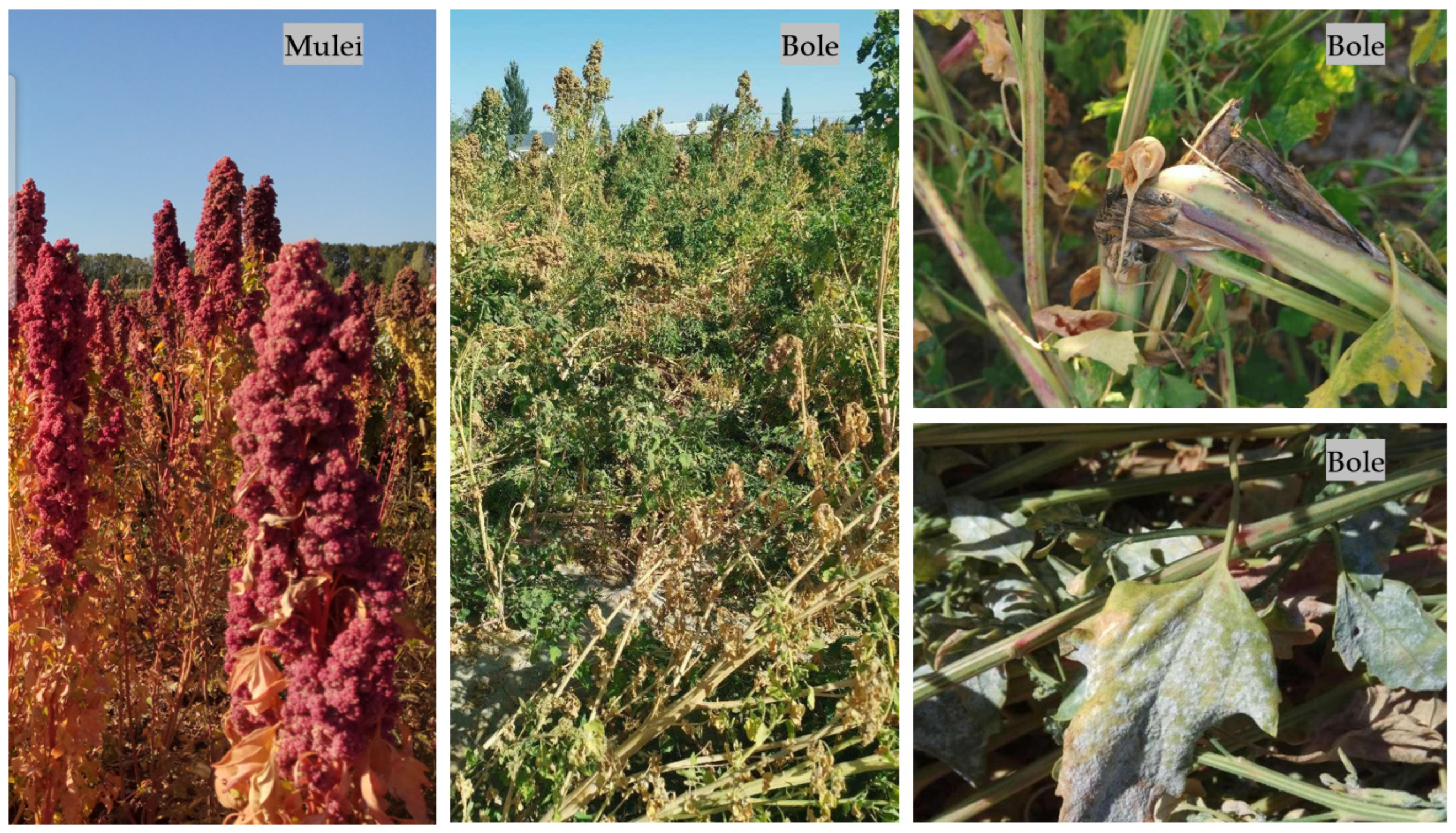
| Test Station | Topsoil, cm | Organic Matter, g·kg−1 | Available Nitrogen, mg·kg−1 | Available Phosphorus, mg·kg−1 | Available Potassium, mg·kg−1 | PH | Total Salts, mg·g−1 | Field Capacity, % | Wilting Point, % | Soil Bulk Density, g·cm−3 |
|---|---|---|---|---|---|---|---|---|---|---|
| Mulei | 0–20 | 17.48 | 69.50 | 45.25 | 384.00 | 7.84 | 0.65 | 21.73 | 10.12 | 1.64 |
| 20–40 | 12.80 | 52.75 | 14.55 | 269.15 | 7.78 | 0.50 | 21.34 | 9.76 | 1.62 | |
| 40–60 | 7.00 | 36.25 | 6.85 | 151.30 | 7.15 | 0.31 | 21.12 | 9.54 | 1.59 | |
| 60–80 | 4.90 | 25.38 | 4.80 | 105.91 | 5.01 | 0.21 | 20.75 | 9.21 | 1.58 | |
| Bole | 0–20 | 3.43 | 94.31 | 27.72 | 304.85 | 8.40 | 0.36 | 21.75 | 9.75 | 1.60 |
| 20–40 | 3.23 | 82.12 | 21.97 | 253.43 | 8.32 | 0.32 | 22.77 | 9.84 | 1.60 | |
| 40–60 | 3.17 | 75.31 | 18.34 | 185.24 | 8.23 | 0.25 | 22.67 | 10.34 | 1.59 | |
| 60–80 | 2.92 | 65.32 | 11.21 | 132.54 | 8.32 | 0.15 | 21.90 | 9.54 | 1.57 |
| Growth Stage | Date | Days of Growth | 2020/2021 | |||
|---|---|---|---|---|---|---|
| YM1/YM11 | YM2/YM12 | YM3/YM13 | CK/CK1 | |||
| Germination | 24 April–2 May | 9 | 0 | 0 | 0 | 0 |
| Seedling | 3 May–25 May | 23 | 30 | 30 | 30 | 30 |
| Branching | 26 May–19 June | 25 | 0 | 0 | 0 | 0 |
| Heading | 20 June–6 July | 19 | 45 | 52 | 60 | 67 |
| Flowering | 7 July–22 July | 15 | 45 | 52 | 60 | 67 |
| Grain filling | 23 July–3 September | 42 | 135 | 157 | 180 | 202 |
| Ripening | 4 September–15 September | 12 | 0 | 0 | 0 | 0 |
| Irrigation Depth | 145 | 255 | 292 | 330 | 367 | |
| Year | Treatment | Growth Stages | ||||||
|---|---|---|---|---|---|---|---|---|
| Seedling | Branching | Heading | Flowering | Grain Filling | Ripening | |||
| 2020 Mulei | YM1 | 45.80 a | 51.22 a | 54.34 c | 71.87 c | 182.89 d | 21.89 b | 428.01 c |
| YM2 | 45.28 a | 51.46 a | 60.09 c | 78.23 bc | 207.45 c | 24.42 a | 466.94 bc | |
| YM3 | 46.47 a | 51.36 a | 68.56 b | 85.63 ab | 232.76 b | 24.88 a | 509.66 ab | |
| CK | 46.69 a | 51.78 a | 75.87 a | 92.68 a | 256.30 a | 26.50 a | 549.81 a | |
| 2021 Bole | YM11 | 41.49 a | 54.90 a | 58.71 c | 73.85 c | 192.83 c | 30.17 a | 451.94 c |
| YM12 | 41.86 a | 54.43 a | 64.74 c | 81.26 bc | 216.30 b | 30.41 a | 489.00 bc | |
| YM13 | 41.77 a | 54.82 a | 72.32 b | 87.88 ab | 236.79 b | 31.13 a | 524.71 ab | |
| CK1 | 41.68 a | 55.81 a | 80.24 a | 95.21 a | 261.93 a | 32.02 a | 566.89 a | |
| Year | Treatment | Growth Stages | |||||
|---|---|---|---|---|---|---|---|
| Seedling | Branching | Heading | Flowering | Grain Filling | Ripening | ||
| 2020 Mulei | YM1 | 0.41 a | 0.37 a | 0.61 c | 0.86 c | 0.89 d | 0.56 b |
| YM2 | 0.41 a | 0.37 a | 0.67 c | 0.94 bc | 1.01 c | 0.62 a | |
| YM3 | 0.42 a | 0.37 a | 0.77 b | 1.03 ab | 1.13 b | 0.64 a | |
| CK | 0.42 a | 0.38 a | 0.85 a | 1.11 a | 1.25 a | 0.68 a | |
| 2021 Bole | YM11 | 0.38 a | 0.38 a | 0.62 c | 0.88 c | 0.93 c | 0.61 a |
| YM12 | 0.38 a | 0.37 a | 0.68 c | 0.97 bc | 1.04 b | 0.62 a | |
| YM13 | 0.38 a | 0.38 a | 0.76 b | 1.04 ab | 1.14 b | 0.63 a | |
| CK1 | 0.38 a | 0.38 a | 0.84 a | 1.13 a | 1.26 a | 0.65 a | |
| Year | Treatment | Growth Stages | |||||
|---|---|---|---|---|---|---|---|
| Seedling | Branching | Heading | Flowering | Grain Filling | Ripening | ||
| 2020 Mulei | YM1 | 1.100 a | 20.040 a | 61.920 c | 108.620 d | 296.010 c | 306.860 b |
| YM2 | 1.120 a | 19.020 a | 65.530 bc | 131.800 c | 331.440 b | 328.360 b | |
| YM3 | 1.120 a | 18.690 a | 69.290 ab | 154.020 b | 369.170 a | 365.600 a | |
| CK | 1.130 a | 20.460 a | 73.450 a | 173.000 a | 394.360 a | 386.430 a | |
| 2021 Bole | YM11 | 1.080 a | 17.900 a | 73.660 b | 167.900 c | 328.840 c | 312.960 c |
| YM12 | 1.120 a | 17.720 a | 79.600 ab | 196.540 b | 351.880 bc | 336.410 bc | |
| YM13 | 1.110 a | 18.030 a | 83.000 a | 227.570 a | 385.230 ab | 365.200 ab | |
| CK1 | 1.110 a | 18.770 a | 87.450 a | 244.443 a | 405.980 a | 382.970 a | |
| Year | Growth Parameter | Growth Stage | |||||
|---|---|---|---|---|---|---|---|
| Seedling | Branching | Heading | Flowering | Grain Filling | Ripening | ||
| 2020 Mulei | Plant height | 0.940 ** | 0.783 ** | 0.866 ** | 0.970 ** | 0.959 ** | 0.986 ** |
| Stem diameter | 0.746 ** | 0.911 ** | 0.959 ** | 0.973 ** | 0.985 ** | 0.952 ** | |
| Leaf area | 0.623 * | 0.976 ** | 0.961 ** | 0.973 ** | 0.979 ** | 0.974 ** | |
| Root dry mass | 0.919 ** | 0.796 ** | 0.938 ** | 0.971 ** | 0.982 ** | 0.919 ** | |
| Stem dry mass | 0.845 ** | 0.577 * | 0.988 ** | 0.984 ** | 0.992 ** | 0.916 ** | |
| Leaf dry mass | 0.976 ** | 0.991 ** | 0.889 ** | 0.986 ** | 0.997 ** | 0.969 ** | |
| Fruit dry mass | - | - | 0.808 ** | 0.968 ** | 0.989 ** | 0.944 ** | |
| Biological yield | 0.964 ** | 0.766 ** | 0.965 ** | 0.984 ** | 0.997 ** | 0.943 ** | |
| 2021 Bole | Plant height | 0.977 ** | 0.832 ** | 0.862 ** | 0.974 ** | 0.948 ** | 0.755 ** |
| Stem diameter | 0.891 ** | 0.990 ** | 0.979 ** | 0.978 ** | 0.992 ** | 0.817 ** | |
| Leaf area | 0.669 * | 0.960 ** | 0.918 ** | 0.997 ** | 0.973 ** | 0.801 ** | |
| Root dry mass | 0.953 ** | 0.804 ** | 0.959 ** | 0.972 ** | 0.993 ** | 0.909 ** | |
| Stem dry mass | 0.833 ** | 0.901 ** | 0.933 ** | 0.970 ** | 0.994 ** | 0.772 ** | |
| Leaf dry mass | 0.974 ** | 0.806 ** | 0.943 ** | 0.976 ** | 0.966 ** | 0.873 ** | |
| Fruit dry mass | - | - | 0.989 ** | 0.997 ** | 0.971 ** | 0.833 ** | |
| Biological yield | 0.970 ** | 0.960 ** | 0.959 ** | 0.984 ** | 0.986 ** | 0.828 ** | |
| Year | Treatment | TSW (g) | Yield (Mg·ha−1) | Biological Yield (Mg·ha−1) | HI | WP (kg·m−3) |
|---|---|---|---|---|---|---|
| 2020 Mulei | YM1 | 2.226 a | 1.364 b | 5.47 b | 0.249 b | 0.318 b |
| YM2 | 2.390 a | 1.509 b | 5.91 b | 0.255 b | 0.323 b | |
| YM3 | 2.410 a | 2.030 a | 6.63 a | 0.306 a | 0.398 a | |
| CK | 2.389 a | 2.178 a | 7.00 a | 0.311 a | 0.396 a | |
| 2021 Bole | YM11 | 2.160 b | 1.374 b | 5.59 c | 0.246 a | 0.304 a |
| YM12 | 2.274 ab | 1.512 ab | 6.04 bc | 0.250 a | 0.309 a | |
| YM13 | 2.380 ab | 1.594 a | 6.58 ab | 0.242 a | 0.304 a | |
| CK1 | 2.410 a | 1.631 a | 6.90 a | 0.236 a | 0.288 a |
| Area | Dependent Variable | Regression Equation | R2 | Combination of Treatment for Max y | |
|---|---|---|---|---|---|
| x/mm | ymax | ||||
| 2020 Mulei | Yield (Mg·ha−1) | y = 7.29x − 1791.733 | 0.95 | 549.81 | 2.18 |
| Biological yield (Mg·ha−1) | y = 13.05x − 123.90 | 0.99 | 549.81 | 7.00 | |
| Water productivity (kg·m−3) | y = 0.001x − 0.014 | 0.83 | 509.66 | 0.40 | |
| 2021 Bole | Yield (Mg·ha−1) | y = 2.22x + 398.21 | 0.92 | 566.89 | 1.63 |
| Biological yield (Mg·ha−1) | y = 11.73x + 321.84 | 0.98 | 566.89 | 6.90 | |
| Water productivity (kg·m−3) | y = 0.00x + 0.374 | 0.59 | 489.00 | 0.31 | |
Disclaimer/Publisher’s Note: The statements, opinions and data contained in all publications are solely those of the individual author(s) and contributor(s) and not of MDPI and/or the editor(s). MDPI and/or the editor(s) disclaim responsibility for any injury to people or property resulting from any ideas, methods, instructions or products referred to in the content. |
© 2025 by the authors. Licensee MDPI, Basel, Switzerland. This article is an open access article distributed under the terms and conditions of the Creative Commons Attribution (CC BY) license (https://creativecommons.org/licenses/by/4.0/).
Share and Cite
Awa, M.; Yusuying, A.; Zhao, J.; Tumaerbai, H. Impact of Drip Irrigation Levels on the Growth, Production, and Water Productivity of Quinoa Grown in Arid Climate Conditions. Water 2025, 17, 917. https://doi.org/10.3390/w17070917
Awa M, Yusuying A, Zhao J, Tumaerbai H. Impact of Drip Irrigation Levels on the Growth, Production, and Water Productivity of Quinoa Grown in Arid Climate Conditions. Water. 2025; 17(7):917. https://doi.org/10.3390/w17070917
Chicago/Turabian StyleAwa, Mukeran, Aisanjiang Yusuying, Jinghua Zhao, and Hudan Tumaerbai. 2025. "Impact of Drip Irrigation Levels on the Growth, Production, and Water Productivity of Quinoa Grown in Arid Climate Conditions" Water 17, no. 7: 917. https://doi.org/10.3390/w17070917
APA StyleAwa, M., Yusuying, A., Zhao, J., & Tumaerbai, H. (2025). Impact of Drip Irrigation Levels on the Growth, Production, and Water Productivity of Quinoa Grown in Arid Climate Conditions. Water, 17(7), 917. https://doi.org/10.3390/w17070917







